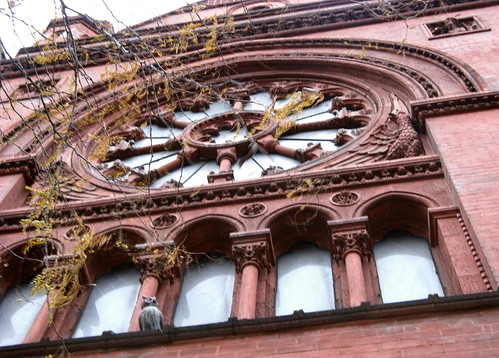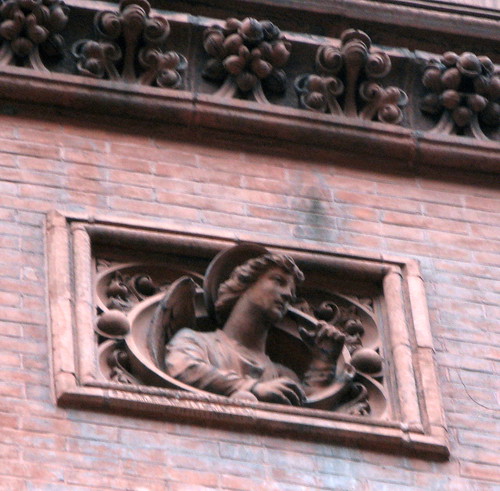New York’s sacred places of worship possess countless life stories and historical chapters as well as inspiring and magnificent art, architecture, and design. Jacob Riis, the social reformer and photographer whose works brought to light the suffering of the poor living in New York City tenements, was one of the early parishioners of the Church of the Resurrection, the oldest church in Richmond Hill, Queens. In the 1990s, those restoring the façade of the 1844 Gothic building of the First Unitarian Congregational Society in Brooklyn found the original oyster shell mortar and matched it. The building contains splendid Tiffany stained glass windows. In the Lower East Side, thanks to the dedicated efforts to save a structure once in decline, the Eldridge Street Synagogue, a space that long ago provided inspiration to newly arriving Jewish immigrants arriving in America from Russia and Poland, still survives.
That each of these places remains standing and vital to their communities personifies resilience and a miracle. That this weekend New Yorkers and others can see and tour various sacred places of New York City and State is a priceless opportunity. This weekend, May 20 and 21, the New York Landmarks Conservancy is holding its 6th annual Sacred Sites Open House, during which more than 170 churches, temples, synagogues, and meeting houses in New York City and State will be open for exploring the architecture, art, history, and cultural programs of these places. In 2016, the New York Landmarks Conservancy is also marking the 30th anniversary of the group’s Sacred Sites Program, a statewide initiative to foster and support, through technical and financial assistance, preservation endeavors for these historic places.
The Open House encompasses a wide variety of religious congregations, time periods, and architectural styles, from the architecture of a unique Ukrainian Catholic Church that drew from the wooden churches of the Carpathian Mountains to structures of the Gothic Revival, Romanesque Revival, and Shingle styles. Geographically, a significant number are in New York City, yet the open house includes worship sites eastward to the tip of Long Island, upstate and westward to Niagara Falls and Buffalo, and northward to the historic village of Monroe in the state’s rolling farmlands just south of the Canadian border.
Resources to Plan a Visit
Through its open house, the New York Landmarks Conservancy has several objectives. The group aims to encourage religious institutions to open their doors to visitors as a way to build support for ongoing preservation efforts; to inspire residents to appreciate the history, art, and architectural richness of worship sites right in their own backyards; and to increase public awareness of the many programs and services these spiritual institutions provide that benefit their communities and neighborhoods today.
For those participating in the open house this weekend, the conservancy has posted excellent resources to plan where you can go and what you can see. The conservancy’s main Open House site is a gateway with links for a searchable database that features locations, maps, images, styles, and special events, and to a statewide map. Each sacred site’s page has information on the days and times of availability for touring and related special activities. A separate page also outlines a number of special, pre-booked tours in each of New York City’s boroughs. More information is available through the New York Landmarks Conservancy’s Facebook page.
The exterior of the Midtown Parish of Our Saviour New York church has an intricate central rose window. The church, built in 1885-1886, is part of the Sacred Sites Open House weekend.
Our Saviour New York church, on West 57th Street, has various expressive angel figures in its exterior terra cotta ornamentation.
With so many worship houses that have been destroyed over the years or are in decline, an event such as this Open House highlights the treasures of architecture, spirituality, and community that, fortunately, remain. The sites throughout New York are places of diverse and inspiring design, community transformation, and cultural history. They are tales in stone, wood, concrete, brick, and glass that embody humanity’s hope for salvation, capacity for artistic wonder, creation of havens, yearning for social justice, and range of spiritual beliefs. The Midtown Parish of Our Saviour New York on West 57th Street in Manhattan, for example, was once the Catholic Apostolic Church, where the adherents believed that the Second Coming of Jesus Christ was near and that the church must hew to the ways of the early Christian Church. (See “Terra Cotta Tales: Apostolic Church” on Mindfulwalker.com.) Today, it’s one of a branch of churches of Our Saviour New York, is associated with the Lutheran Church-Missouri Synod, and heralds itself as a neighborly gathering place for the modern world.
Each has its beauty, from the simple and vernacular to the soaring and grand. Each has its community. Each has its story, one that can be discovered and appreciated this weekend in the Sacred Sites Open House.





Wonderful resource, Susan! The Landmarks Conservancy is really doing a great job. We have a local initiative here in Lorain County (OH) called SACRED LANDMARKS, and the volunteers of that group also work hard to spread the word and value of preservation. I hope you will be visiting some of the New York sites and will share more with us!
Dear Phyllis,
Isn’t it an amazing resource? I look through the New York Landmarks Conservancy’s site, database, and map, and it beckons me to do lots of exploring and some seeking of beautiful spiritual space. Yes, I plan to follow up.
The Lorain County Sacred Landmarks Initiative looks excellent, too! The ability to search by city is great. I feel heartened that these initiatives are going on, especially considering how under threat many worship spaces are.
I’m so happy you responded!
Susan